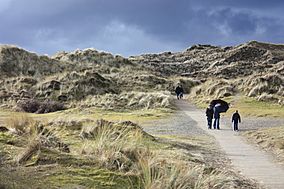Murlough Nature Reserve facts for kids
Quick facts for kids Murlough Nature Reserve |
|
|---|---|

Murlough Nature Reserve, February 2010
|
|
| Location | County Down, Northern Ireland |
| Nearest city | Belfast |
| Area | 697 acres (2.82 km2) |
| Established | 1967 |
| Governing body | National Trust |
Murlough Nature Reserve lies on the coast of County Down in Northern Ireland, situated close to Newcastle. It has views of Slieve Donard, the highest peak in the Mourne Mountains and Dundrum Bay. Its 6,000-year-old sand dune system has been managed by the National Trust since 1967, when it became Ireland's first nature reserve. Grid ref: J414351.
Contents
Features
At 697 acres, it is the most extensive example of dune heath within Ireland, with a network of paths and boardwalks through the dunes. Breeding birds include meadow pipit, skylark, cuckoo, stonechat, linnet and reed bunting. Shorehauling grey seal and common seals are also common in the area. Between 50 and 130 common and grey seals regularly use the area for moulting, resting and feeding. Rare plants local to the site are pyramidal orchid and carline thistle.
It also has access to a shingle beach and four mile Blue Flag strand.
Murlough makes up one fifth of all dune heathland in the British Isles, but remains under threat from the encroachment of scrub vegetation such as bracken and gorse and non-native species such as Sea Buckthorn. In 1999 the National Trust established the South Down Heathland project, a five-year programme to protect the habitat. It has been designated an Area of Special Scientific Interest and a Special Area of Conservation.
History
The area has evidence of human habitation from Neolithic times, through the Bronze Age to the present day. In the 12th century a rabbit warren was established on the site by the Normans for their meat and pelts. This had a major influence on the development of the heath and grassland found today. A particularly stormy period in the 13th and 14th centuries resulted in a huge movement of sand which led to the unusually high dunes also found today.
The sand dunes were extensively used by the US Army during the Second World War.
Moths and butterflies
Several rare moths and butterflies can be found within the reserve. Of the 23 butterfly species recorded at Murlough, the marsh fritillary (Euphydryas aurinia), is of European importance - other notable species include dark-green fritillary (Argynnis aglaja), grayling (Hipparchia semele) and cryptic wood white (Leptidea juvernica). One species, the wall brown butterfly (Lasiommata megera) has not been recorded for several years and is considered extinct at this site. Over 750 species of moth have been recorded within the boundary of Murlough Nature Reserve, more than at any other site in Northern Ireland - examples include small elephant hawkmoth (Deilephila porcellus), sand dart (Agrotis ripae) and the micro moths Pyrausta cingulata and Hysterophora maculosana. A total of 775 Lepidoptera (butterflies and moths) have been recorded within the nature reserve boundary.
Notable migrant species noted in the area have included: cosmopolitan (Leucania loreyi), tawny pinion (Lithophane semibrunnea), double line (Mythimna turca), white-speck, the delicate and L-album wainscot
In 2012 a Stephens' gem (Megalographa biloba) was recorded at Murlough NNR - this was the 1st record for Ireland of this North American moth species.
Gallery






